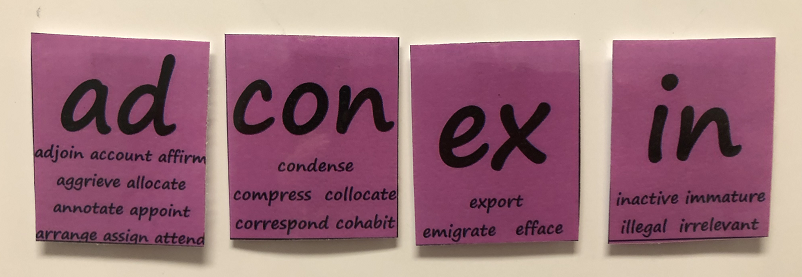New moveable alphabet and affixes
0 Replies
After many failed attempts and two broken laminators (gah), I’ve finally created a moveable alphabet which has lots of prefixes and suffixes but still leaves space on my whiteboard to write/build words, looks good and handles well (its chunkier tiles stick with a satisfying click, and don’t fall off easily).
The set has 140 single-sided tiles and 56 double-sided tiles, representing:
- 11 consonant spellings used before vowels, like ‘j’, ‘h’, ‘v’, ‘wh’ and ‘kn’ (these are green, like a traffic light’s ‘go’ signal),
- 48 vowel spellings like ‘u’, ‘ai’, ‘ea’, ‘oo’, ‘ur’, ‘igh’ and ‘ough’ (orange, meaning ‘caution’, because vowels are the trickiest part of English spelling).
- 36 consonant spellings used after vowels like ‘ck’, ‘ng’, ‘ff’, ‘ve’, ‘tch’, ‘ce’ and ‘mb’ (red, for stop and blend).
- 23 consonant spellings which are used both before and after vowels, like ‘k’, ‘m’, ‘s’, ‘sh’ and ‘ph’ (yellow).
- 22 prefixes (purple).
- 50 suffixes (blue).
All tiles are now the same size, making them easier to cut up and store/carry in a toolbox, if you’re on the go. There are two or three copies of high-use tiles, so you shouldn’t run out of letters like ‘e’ or ‘n’ when building long words (spares not shown in photos above and below). Having double-sided tiles makes the set more compact, and helps establish the concept that speech sounds/affixes are often written more than one way. The photo below shows the ‘flip’ side (as the vinyl buffs say) of the double-sided tiles.

Early, low-verbiage morphology teaching
As well as using this set to build and change words using graphemes, these tiles help you show children how to add prefixes and suffixes to base words without resorting to complex ‘if-then’, ‘except-if’ type language, which young and language-disordered children find hard to understand.
For example, build the word sun, then add:
- suffix -s, to make suns, as in ‘the lizard suns itself on a rock’ (3rd person verb) or ‘many stars are suns’ (plural).
- suffix -‘s, to make sun’s, as in ‘the sun’s rays are bright today’ (possessive)
- suffix -ed, to make sunned, as in ‘the snake sunned itself on that rock yesterday’ (past tense) or ‘He had sunned himself for years, so his skin was leathery’ (past participle). Kids can be told that ‘suned’ is pronounced rhyming with ‘pruned’, so when a vowel suffix is added, we flip the ‘n’ over to get ‘nn’, which keeps the /u/ sound in ‘sun’.
- suffix -ing, to make sunning, as in ‘sunning yourself feels nice, but don’t get burnt’ (present participle). Again, flip the ‘n’ tile over to get ‘nn’.
- suffix -y, to make sunny, as in ‘It’s a lovely, sunny day’ (again, flip the ‘n’).
Some kids get a real six-words-for-the-price-of-one buzz from this. They want to try other prefixes and suffixes, to see what other words they can make. I’ve had to ask a few of them to stop it and sit down, because we have other work to do.
This set also makes it easy to teach the concept that spellings can stay the same when sounds change during word-building e.g.
- Build the word heave, with vowel sound /ee/ represented by ‘ea’, then add suffix -y to get heavy, with vowel sound /e/ represented by ‘ea’.
- Build the word south and notice that the vowel sound changes, but the spelling stays the same, when we add suffix -ern to make southern.
- Build words like act, music and discuss, and notice how their last sounds change when we add suffix -ion to get action, musician and discussion. Preserving base word spellings helps us know what the new word means.
Each tile has example words showing the different ways the spelling can be pronounced. Usually there are only one or two ways, but some spellings have small groups of unusual words (like grapheme ear: bear, pear, wear, tear, swear and heart).
Some prefixes assimilate to base words, for example ‘in’ meaning ‘not’ changes to ‘im’ when added to words starting with lip sounds, like ‘possible’ and ‘modest’. Example words on prefix tiles illustrate this.

This set doesn’t include the six ‘split vowel’ spellings in previous moveable alphabets: a…e as in ‘make’, e…e as in ‘these’, i…e as in ‘like’, o…e as in ‘hope’, u…e as in ‘cute/flute’ and y…e as in ‘type’. Their unusual shape was a bit distracting and fiddly, and they required different logic, potentially adding cognitive load.
The original sets already had several word-final consonant-e spellings: ce as in voice, ge as in large, le as in bottle, se as in house/please, ve as in give, ze as in breeze. Replacing the ‘split’ spellings with extra consonant-e spellings (be, de, fe, ke, me, ne, pe, re and te) only adds three extra graphemes, follows the same left-to-right logic of the rest of the set, and makes it easier to build common words like ‘come/some’ and ‘done/gone’. These reasons, plus ease of making/handling/storing tiles have motivated the change. Sorry about that, if you prefer ‘split’ spellings, but please listen to Episode 11 of the Sounds-Write podcast. You might also be persuaded.
If you already have a serviceable Spelfabet or other moveable alphabet, you can add the new bits of this one to it, keeping the file on your computer so you can print, assemble and use it in full once your existing set finally bites the dust.
Now I just need to revise my wordlists and sequences to match this version of the alphabet. Please bear with me while I do. If you have any feedback about this version, I’d love you to put it in the comments.




Leave a Reply